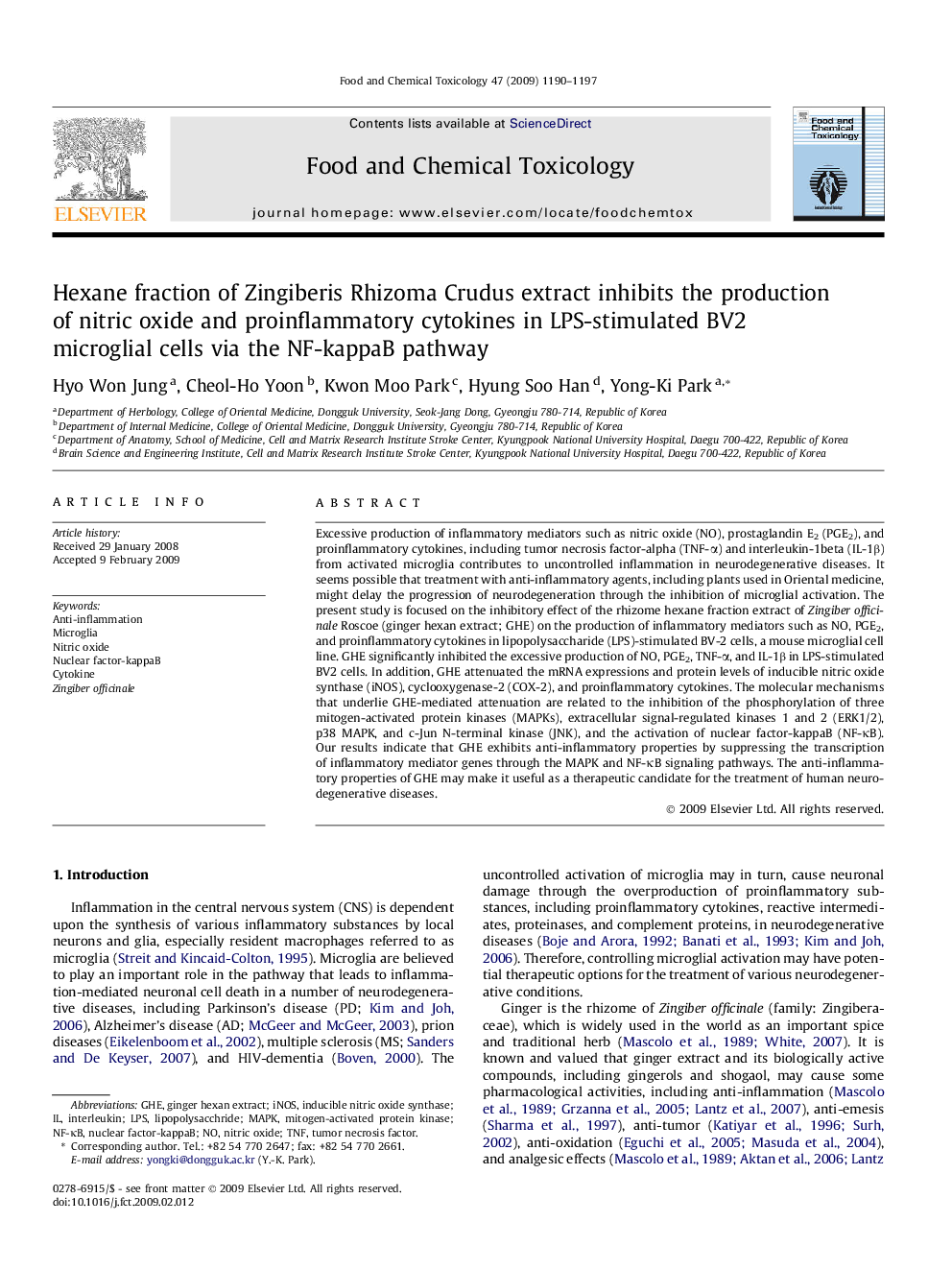| کد مقاله | کد نشریه | سال انتشار | مقاله انگلیسی | نسخه تمام متن |
|---|---|---|---|---|
| 5854384 | 1130901 | 2009 | 8 صفحه PDF | دانلود رایگان |
عنوان انگلیسی مقاله ISI
Hexane fraction of Zingiberis Rhizoma Crudus extract inhibits the production of nitric oxide and proinflammatory cytokines in LPS-stimulated BV2 microglial cells via the NF-kappaB pathway
دانلود مقاله + سفارش ترجمه
دانلود مقاله ISI انگلیسی
رایگان برای ایرانیان
موضوعات مرتبط
علوم زیستی و بیوفناوری
علوم کشاورزی و بیولوژیک
دانش تغذیه
پیش نمایش صفحه اول مقاله

چکیده انگلیسی
Excessive production of inflammatory mediators such as nitric oxide (NO), prostaglandin E2 (PGE2), and proinflammatory cytokines, including tumor necrosis factor-alpha (TNF-α) and interleukin-1beta (IL-1β) from activated microglia contributes to uncontrolled inflammation in neurodegenerative diseases. It seems possible that treatment with anti-inflammatory agents, including plants used in Oriental medicine, might delay the progression of neurodegeneration through the inhibition of microglial activation. The present study is focused on the inhibitory effect of the rhizome hexane fraction extract of Zingiber officinale Roscoe (ginger hexan extract; GHE) on the production of inflammatory mediators such as NO, PGE2, and proinflammatory cytokines in lipopolysaccharide (LPS)-stimulated BV-2 cells, a mouse microglial cell line. GHE significantly inhibited the excessive production of NO, PGE2, TNF-α, and IL-1β in LPS-stimulated BV2 cells. In addition, GHE attenuated the mRNA expressions and protein levels of inducible nitric oxide synthase (iNOS), cyclooxygenase-2 (COX-2), and proinflammatory cytokines. The molecular mechanisms that underlie GHE-mediated attenuation are related to the inhibition of the phosphorylation of three mitogen-activated protein kinases (MAPKs), extracellular signal-regulated kinases 1 and 2 (ERK1/2), p38 MAPK, and c-Jun N-terminal kinase (JNK), and the activation of nuclear factor-kappaB (NF-κB). Our results indicate that GHE exhibits anti-inflammatory properties by suppressing the transcription of inflammatory mediator genes through the MAPK and NF-κB signaling pathways. The anti-inflammatory properties of GHE may make it useful as a therapeutic candidate for the treatment of human neurodegenerative diseases.
ناشر
Database: Elsevier - ScienceDirect (ساینس دایرکت)
Journal: Food and Chemical Toxicology - Volume 47, Issue 6, June 2009, Pages 1190-1197
Journal: Food and Chemical Toxicology - Volume 47, Issue 6, June 2009, Pages 1190-1197
نویسندگان
Hyo Won Jung, Cheol-Ho Yoon, Kwon Moo Park, Hyung Soo Han, Yong-Ki Park,